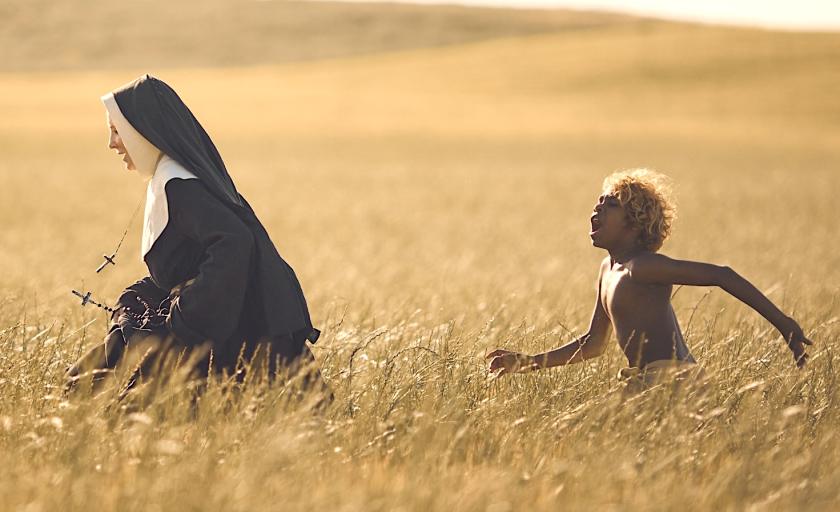This is writer-director Warwick Thornton’s third feature film, his first since 2017's excellent Sweet Country, and it took him 18 years to bring it to the screen. He describes it as “a really special one” with “a lot to say”, though viewers may find themselves having to ponder long and hard to figure out The New Boy’s layers of meaning.
It’s a mysterious parable about an Aboriginal boy (Aswan Reid) who we first see involved in a fierce struggle with a mounted police patrol amid miles of Outback countryside, which comes to an end when he’s knocked unconscious by a boomerang. The story is set in the 1940s, and faint echoes of the distant World War occasionally intrude. For instance, we hear that the conflict has caused labour shortages, and there’s a brief discussion about how no new Chevrolet trucks will appear before the war is over.
The boy is subsequently delivered, under cover of darkness, to a monastery orphanage, a spartan operation situated in a vast expanse of bare countryside. The landscape is beautiful in its way, but also loaded with a faint air of menace and foreboding.
 The boy thus comes into the charge of Sister Eileen (Cate Blanchett), who runs the monastery with the aid of a pair of Aboriginal staff-members, George (Wayne Blair, pictured above) and Sister Mum (Deborah Mailman, pictured below). The backdrop to this is the Australian government’s eugenics-style policy of “breed out the black”, whereby indigenous children of mixed descent were removed from their parents and their traditional culture, the idea apparently being that they’d be absorbed into the dominant white gene pool.
The boy thus comes into the charge of Sister Eileen (Cate Blanchett), who runs the monastery with the aid of a pair of Aboriginal staff-members, George (Wayne Blair, pictured above) and Sister Mum (Deborah Mailman, pictured below). The backdrop to this is the Australian government’s eugenics-style policy of “breed out the black”, whereby indigenous children of mixed descent were removed from their parents and their traditional culture, the idea apparently being that they’d be absorbed into the dominant white gene pool.
But Thornton doesn’t go into details about that, instead using a minimalist, allusive form of narrative which nudges you to make the relevant connections yourself. His choice to shoot the piece using just one camera (and three lenses) has conjured an atmosphere of concentration and watchfulness. As the boy becomes integrated into the life of the orphanage, alongside his fellow displaced inmates, it gradually becomes clear that he’s endowed with strange powers. He doesn’t speak English (he hardly speaks at all), but seems to have an unspoken bond with animals. You might call him a snake-whisperer. He is also able to conjure up a kind of sparkly light, like his own private Tinker Bell, which seems to have healing qualities.
 Sister Eileen and her assistants provide some ballast to help the story to keep at least one foot on the ground. Eileen is single-minded in her determination to keep her establishment a safe haven for her charges, to the extent that she has covered up the death of Dom Peter, the monk who was previously in charge. The implication is that she fears that interference by heavy-handed church authorities would upset the delicate little eco-system they’ve established out here in the great beyond. George runs the practical outdoor stuff (harvesting olives, for instance, or organising the extinguishing of brush fires), while Sister Mum is both motherly and big-sisterly to the young boys under her care.
Sister Eileen and her assistants provide some ballast to help the story to keep at least one foot on the ground. Eileen is single-minded in her determination to keep her establishment a safe haven for her charges, to the extent that she has covered up the death of Dom Peter, the monk who was previously in charge. The implication is that she fears that interference by heavy-handed church authorities would upset the delicate little eco-system they’ve established out here in the great beyond. George runs the practical outdoor stuff (harvesting olives, for instance, or organising the extinguishing of brush fires), while Sister Mum is both motherly and big-sisterly to the young boys under her care.
The apotheosis arrives with the delivery of a large carving of Christ, apparently rescued from the wreckage of war. This triggers a profound response in the boy, who develops a lurid obsession with the crucified Christ and his stigmata. Thornton, an Aboriginal himself, has spoken of how “despite it seeming like they clashed, I could see how the Aboriginal spirituality I was raised with and Christianity could actually gel together really well,” but his depiction of that on screen falls over itself trying to make us swallow an outsized portion of disbelief.
Still, he gets a powerful leg up from a superb score by Nick Cave and Warren Ellis, both haunting and epic. If a picture is worth a thousand words, their music is worth a million.














Add comment